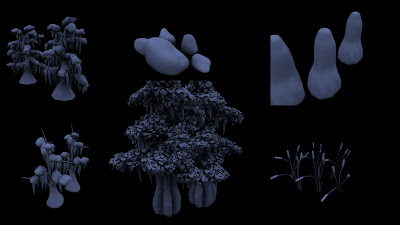 Comment from Ting:
Comment from Ting:Above are examples of the ambient occlusion testing stage. During the process each object needs to reset transformation first, and then baked out brick map and point cloud files. Afterward, use the customized shader “uberplastic” to test if the ambient occlusion is working properly.
Grass
 Comment from Steven:
Comment from Steven:Grass was a fun task to take on. I picked this task up from a fellow classmate and gave it the final touches. There was a good deal of experimentation with it. Although I wish Maya would allow me to create color ramps along the length of the grass blade, I did manage to create color variation on the base and tip color through color driven noise. This gave the grass a bit more depth than just two colors.
We decided to go with individual nurb patches of grass which could then be assembled throughout each scene. This made placement more interactive and mobile. Originally we were going with the fur attributes method but that ended up being too much trial and error to get the right settings in certain areas.
RIB archive issue and solution
Comment from Travis:
This last milestone has been a difficult process of vetting textures and shaders before they can be pushed out to all of the shots. Unfortunately that means doing the same task many times. After running into several issues with the RIB archives for the trees, it became apparently that I had made a grave mistake in changing the scale before exporting. In doing so, I corrupted the bounding box data for the ribs, causes errors in all of the scenes that use them.
Luckily because the ribs were created procedurally, they could be manipulated procedurally. I whipped up a bit of code that would resize the bounding boxes of the trees without changing the geometry in the scene. Using MEL it was a fairly straightforward task to iterate through the Trees RIB Archives because they were all named "R_PLANT_#".
This snipped of code goes through and expands the vertices (increases the size of the bounding box) and then scales down the geometry to its original size. This effectively just resizes the RIB archives trees to fit into our shots.select -r "*:R_PLANT_*";
$GEOM = `ls -selection`;
$counter =0;
for($i in $GEOM)
{
if($counter % 2 == 0)
{
$count = `polyEvaluate -v $i`;
select($i + ".vtx [0:" + ($count[0] - 1) + "]");
scale -r 10 10 10;
move -r 0 1000 0;
select $i;
scale -r .1 .1 .1;
move -r 0 -100 0;
}
$counter++;
}





No comments:
Post a Comment